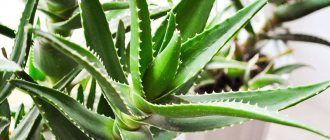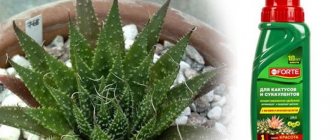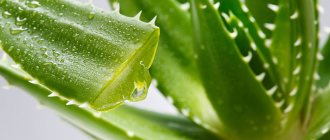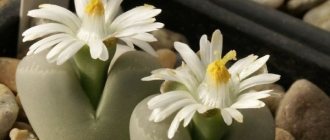If treated well, it will live on the windowsill for years and even decades. From the article you will learn how to provide proper care for aloe vera at home and whether it is really possible to “persuad” it to bloom.
Aloe Vera - description of the species
Aloe Vera means "Aloe True". The Latin word aloe is translated as “bitter”, the Greek άλός is salt (the plant juice tastes like sea water), the Arabic alloeh is a substance with a pronounced bitter taste.
Aloe as a medicine has been accompanying humans for four thousand years. This is confirmed by cuneiform writing on Sumerian tablets dating back to 2100 BC. e. However, images of this plant were also found on the walls of ancient Egyptian temples built 4 thousand years BC.
Everything, including the appearance and biological characteristics of Aloe itself, suggests that the plant first appeared in hot and dry Africa, and then spread to all other continents. In the wild, it is found on the Arabian Peninsula, Madagascar, the Canary Islands, and North Africa.
Aloe Vera forms a bush with a short stem. The roots are poorly developed. The leaves are long (up to 60 cm), fleshy, covered with thorns along the edges. Many people mistakenly call this succulent a cactus because it can also accumulate and store water. Thanks to this ability, Aloe Vera survived severe climate changes on Earth and today still serves people. In extreme situations, the pores on the skin close, and moisture is retained in the leaves for a long time.
There are 500 species of aloe in nature, but only 5 of them are considered medicinal. Aloe Vera occupies a leading position in this top five; it brings maximum benefits to humans. Growing it is a profitable business. Entire plantations are planted, and there are processing plants.
Aloe vera is considered the most valuable for its medicinal properties among more than half a thousand species of aloe.
Today, this is the only plant that treats burns from the strongest light radiation generated by an atomic explosion. Thus, this ancient natural remedy can be called a miracle of modern times.
Indications for use
For what diseases does aloe help and provide a therapeutic effect?
- Stomach treatment. Agave is effective for chronic gastritis and peptic ulcers. The plant is also used for infectious infections, for example, dysentery. Aloe is a powerful natural antibiotic; it kills E. coli and dysentery.
- Constipation. Aloe vera products are known to have a strong laxative effect. It is best to use sabur - a yellow, bitter powder made from aloe. It is taken in small doses - 0.1 g, diluted with water. The medicine eliminates chronic and atonic constipation, increasing the tone of intestinal smooth muscles. For example, in Germany, aloe is recognized as a laxative by the national health service. In pharmacology, it is added to various laxatives. The flower also effectively treats colitis and enterocolitis - inflammation of the large and small intestines.
- Pancreatitis. When the pancreas becomes inflamed, the outflow of its secretions is often disrupted. Agave juice stimulates the secretion of the pancreas and gall bladder. However, in acute forms of pancreatitis, treatment with aloe can aggravate the disease. But for chronic forms with a lack of enzyme production, the flower can help.
- Angina. The cause of sore throat is staphylococcus or streptococcus, which affects the mucous membrane of the tonsils. The plant prevents the proliferation of staphylococcus and streptococcus and promotes a speedy recovery. However, treatment of a real sore throat (not just a sore throat) is not complete without antibiotics. In this case, agave is included in complex therapy: the throat, tonsils, and pharynx are treated with diluted juice. The plant is also used for other throat diseases - tonsillitis and pharyngitis. In dentistry they treat gum inflammation and stomatitis.
- Diabetes. Toxins, obesity, excess cholesterol, diseased liver and pancreas - all this “organizes” the onset of diabetes in the body. Agave contains many enzymes that break down fats, regulate liver functions, and cleanse the bile ducts, lymph and blood. Aloe restores the chemical balance in the body and normalizes impaired metabolic processes in diabetes mellitus.
- Treatment of a runny nose. With ARVI, flu, and colds, a runny nose is one of the most common symptoms. Agave juice is used to disinfect the nasal passages. It must be diluted with water so as not to dry out the mucous membrane. Recently, information has appeared about the antiviral properties of aloe. The plant may be effective against viral respiratory infections.
- Sinusitis. An otolaryngologist treats sinusitis. Of course, in traditional medicine, agave is not a first choice medicine. Sinusitis is an inflammation of the maxillary sinuses, which can be treated over a long period of time on an outpatient basis. The flower is used as an auxiliary antiseptic and antibacterial agent. Like sore throat, sinusitis is most often treated with antibiotics.
- Diseases of the lower respiratory tract. Aloe is included in the complex treatment of pneumonia, bronchitis, tuberculosis and bronchial asthma. Pork or goose fat and natural butter are added to the mixture to treat a severe, annoying cough. It is believed that agave helps with whooping cough.
- Treatment of aloe wounds, burns and other skin lesions. Aloe can be used externally as an antiseptic. The flower heals well wounds, burns, ulcers, abscesses, dermatitis, any purulent inflammation of the skin, including bacterial ones.
- Poor appetite. Fresh juice is recommended, but in small doses. The bitterness contained in the plant stimulates the production of enzymes and increases appetite.
- Radiation exposure. Together with castor and eucalyptus oils, agave juice is taken to prevent or alleviate radiation sickness due to radiation exposure.
Another property of the flower that is less frequently mentioned is that it is a natural aphrodisiac. It is used to stimulate sexual activity and enhance potency in men.
We recommend reading: Useful properties and contraindications of sweet clover
Aloe Vera propagation methods
Rooting leaf cuttings
Planting materials are taken from different parts of the plant, but are rooted using the same technology.
- Carefully break off the leaf as close to the ground as possible. It should be at least 5–10 cm high.
- We place it in a dark place in the apartment for a day so that the wound dries and heals. You can dip the tear area in crushed charcoal to disinfect.
- Then we bury the leaf in wet sand to a depth of 1 cm. Do not spray the plant and cover it with a jar or film! It is important that only the sand remains wet at all times. After two weeks, Aloe Vera should take root. This can be understood by a more intense green color; a new leaf will appear.
Aloe vera does not have a stem as such, so only the leaf with the base can be rooted separately
We propagate by children (root shoots)
When babies appear at the base of the mother plant - small plants 5-10 cm high with 2-3 leaves, you can use them as planting material. There are two ways to separate them:
- completely remove the mother plant along with the roots, shoots and soil from the pot, carefully disconnect the children along with the roots and plant the plants;
- Carefully dig out the shoots from the pot, without handling the adult plant and trying not to damage the roots.
This is what an adult plant looks like, which has produced shoots suitable for moving to other pots
Growing from seeds
In principle, aloe can be grown from seeds, but this is a long and painstaking process.
- Prepare the soil: 1 part leaf soil (peat), 2 parts turf soil, 2 parts river sand.
- We sow the seeds in early spring. You can lightly sprinkle them with soil or simply press them into the soil.
- We carefully monitor the sowing; the sand should always be moist. The optimal germination temperature is 20 ºC.
- When the first shoots appear, you need to move the plant to a bright window or illuminate it with a fluorescent lamp.
- In the phase of 2–3 leaves, we dive into separate pots.
Aloe Vera seeds are easy to purchase from stores that sell indoor plants.
Aloe shoots ready for picking
Top dressing
When considering how to care for aloe, you should not miss this important stage. Like any other plant that is in the room, the agave also needs to be fed periodically. It is important to consider that only healthy plants are fertilized. If aloe is sick, then first of all it needs to be cured. After replanting a damaged flower, it is recommended to fertilize it no earlier than after 3 months.
It is also worth paying attention to the fact that any fertilizers are applied only after watering. It is recommended to feed the plant exactly when it is actively growing. In order to decide how to care for aloe, the description of the plant should be studied in detail and the optimal feeding for the agave should be selected. For example, experienced flower growers recommend the preparations “Power of Life”, “Agricola” and “Bona Forte”.
It is also recommended to apply fertilizers through a tray. In this case, you can protect the plant from the possible aggressive effects of some components.
Caring for Aloe Vera at home
- Lighting. The plant came to us from sunny Africa, so it loves light. Keep it on a window facing south. In the warm season, take it out onto the veranda, balcony or other room that is bright but not flooded by rain.
- Temperature. Aloe Vera grows well at room temperature (18-22ºC, maximum 30ºC). In winter, it is necessary to either reduce this indicator to 12–14ºC (minimum 10ºC), or illuminate it with a lamp.
- Watering. Aloe is watered moderately when the top layer of soil dries. Water should not fall on the leaves or flow into the outlet.
- Air humidity. Dry air is preferred; spraying the plant is not recommended. If dust or dirt appears on the leaves, remove it all with a damp cloth.
- Feeding. Fertilizers are applied from March to October once every 1–2 months. Stores sell complex fertilizers recommended for all indoor plants, as well as for cacti and succulents (FORTE, Good Power and others).
Aloe Vera is famous for its excellent drought resistance and immunity to varying degrees of humidity; it tolerates the winter heating season well, when the air in apartments is very dry. But excess moisture can lead to rotting of the outlet.
Aloe can be fed with universal fertilizers for all indoor plants or special ones for succulents
Try proven drugs:











